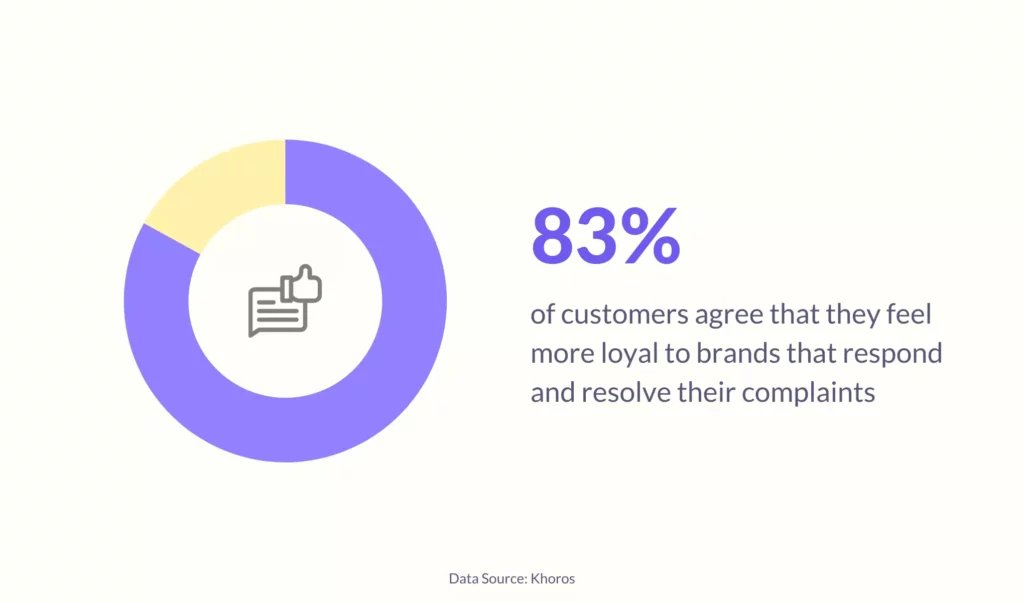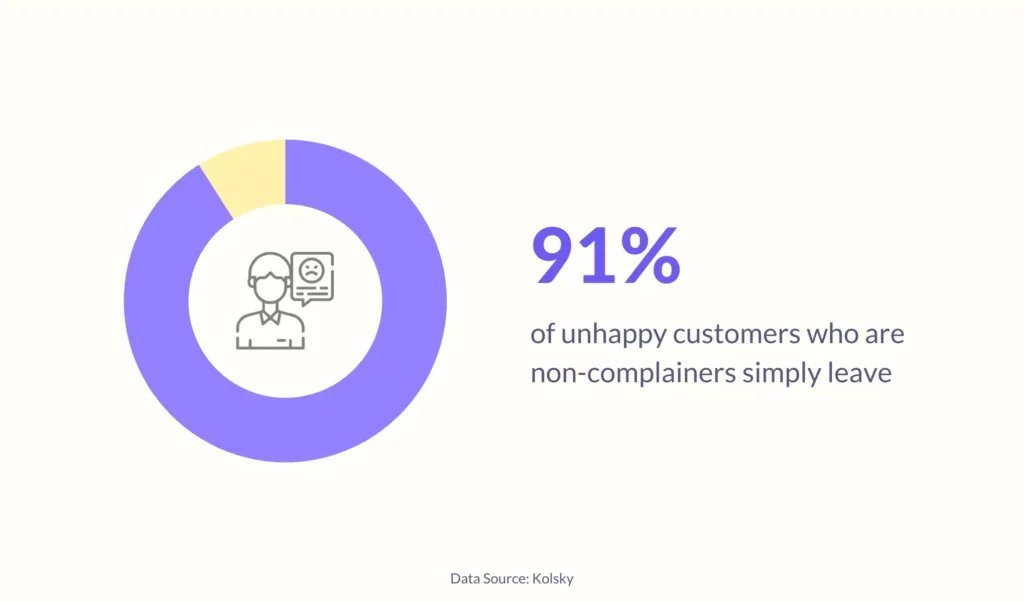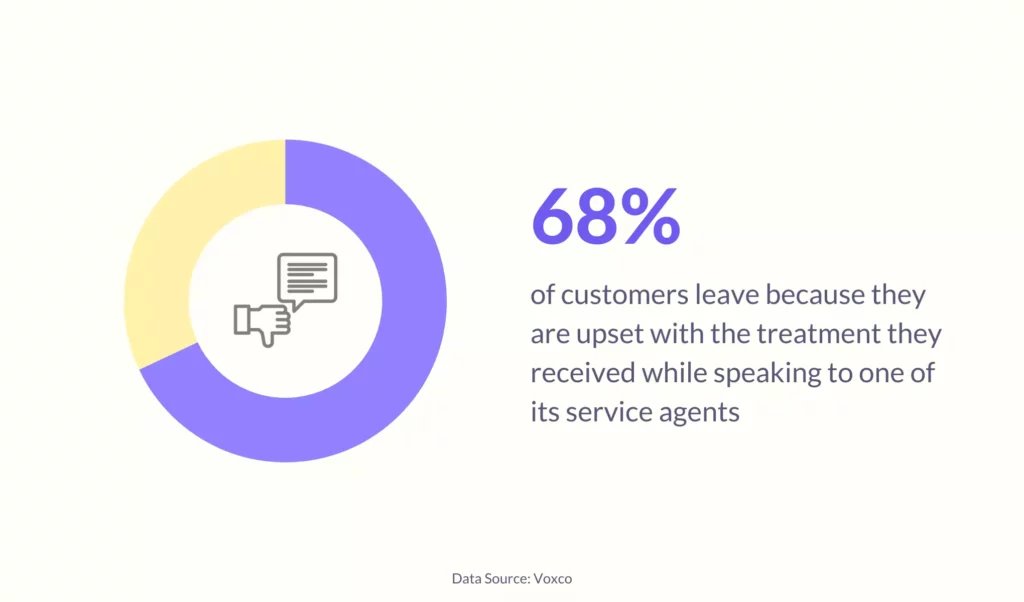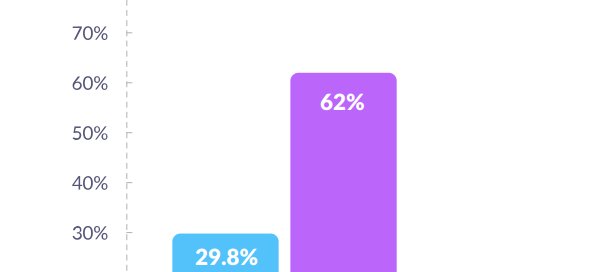7 Signs That Your Customer is Dissatisfied With You

Table of contents
Closing a sales opportunity and welcoming a new customer onboard is definitely a huge win for any business. But the real deal starts after.
When you get a customer on board, it is your responsibility to fulfill the commitments you made at the time of the sale. If you don’t, your customers will soon start regretting their decision and might ultimately switch to your competitors.
In most cases, customers never even tell you about their problem. They simply stop using your product or service.
And this is why you need to lookout for the telltale signs of discontent among customers.
Whether it’s a tepid response to your offerings, a spike in support queries, or a sudden drop in engagement, each sign is an indicator of what needs to change in your customer service.
In this blog we cover the 7 warning signs that your customer is dissatisfied with your service and the types of dissatisfied customers you may encounter.
Table of Contents
- What is Customer Dissatisfaction?
- The Most Common Types of Customer Dissatisfied Customers and How Can You Handle Them
- 7 Signs of Dissatisfied Customers
- 1. The customer complains frequently
- 2. The customer stops engaging with you
- 3. The customer doesn’t remember your name
- 4. The customer regularly compares you to competitors
- 5. The customer doesn’t care about discounts and special offers
- 6. The customer stops trusting you
- 7. The customer frequently refers to your contract terms
- Conclusion
What is Customer Dissatisfaction?
Customer dissatisfaction is the discontent your customers experience when they are unhappy with your product, brand experience, or service. It mostly happens when a customer feels their expectations haven’t been met. Customer dissatisfaction can result in negative reviews, complaints, reduced repeat purchases, decreased loyalty, and ultimately lead to what we dread – churn.
It is important to proactively address customer issues and customers complaints and give them due attention. You can do this by engaging with customers, actively listening to feedback, and promptly addressing customer concerns.
The Most Common Types of Customer Dissatisfied Customers and How Can You Handle Them
Here are some of the different types of dissatisfied customers your business is likely to encounter.
1. The angry customer
An angry customer may express their frustration by raising their voice or getting aggressive. They may be facing issues like poor product quality, long wait lines, or unresolved issues – all of which can frustrate the customer.
Remain calm and empathetic in such situations. It is important to not lose your cool and listen to their concerns. Offer an apology, take them through what you plan to do to resolve their complaint and make sure to follow-up until a solution is delivered.
2. The indifferent customer
An indifferent customer may not have particularly strong emotions or opinions about your brand. They could have had a lackluster experience with your product and they may be on the fence with how they actually feel about their experience. They are likely to rate you average in their feedback. Such a customer is highly likely to churn silently.
The most important step in handling an indifferent customer is to engage them. You’ll need to understand their preferences and offer personalized customer service and recommendations. Collect regular feedback and try to offer benefits and rewards that can buy their interest.
3. The silent customer
Silent customers may not engage with your brand at all. They may not provide any feedback, reviews, or even raise complaints. It becomes difficult for businesses to gauge their experience and identify areas for improvement. Much like an indifferent customer, silent customers are also highly likely to churn.
The best way to handle these customers is to collect their feedback whenever possible. This may mean reaching out to them on their preferred channel. You can use CSAT surveys, feedback forms, or direct outreach. Keep your feedback methods short and simple and make sure they don’t need a lot of effort from the customer.
4. The demanding customer
A demanding customer has extremely high expectations from your business. They may insist on special treatment and accommodations to their needs. They can be quite challenging because even a slight shortcoming from your side can end up in outright negative reviews and feedback. It can also be difficult to handle demanding customers in scenarios where they require additional effort beyond what you can reasonably provide.
The most important thing to remember when handling a demanding customer is to stay professional at all times. Clearly communicate what’s reasonable and practical within your boundaries. Also offer alternative solutions that still provide value to the customer. It is a good idea to define some authority and resources that frontline staff can use when handling such customers.
5. The skeptical customer
Skeptical customers approach brand interactions with a certain degree of doubt. They are not easily convinced and may question the reliability and authenticity of your offerings. They are likely to evaluate a few different competitors before purchasing a product or service. Skeptical customers are hard to convince.
The primary goal of dealing with skeptical customers is to build trust. Be transparent and honest about the information you provide and encourage them to ask as many questions as they’d like. Address concerns in detail and guide them through the process. Offer peer reviews, customer testimonials, and social proof to alleviate their concerns.
6. The churned customer
Churned customers have stopped doing business with you. They may have canceled their subscription or stopped buying your product entirely. Unfortunately they are lost revenue opportunities and the important step is to understand exactly what made them churn. This can help in potentially avoiding more customers from churning for similar reasons.
When it comes to churned customers, it is always better to do an exit survey if they are willing. Gather their feedback and try to analyze why they chose to leave. After a waiting period, you can probably try to re-engage these customers. This is especially applicable if you’ve added features they needed before.
7 Signs of Dissatisfied Customers
Here are some of the most common signs of discontent among customers.
1. The customer complains frequently
Many service experts consider complaints a sign of customer engagement. It shows that the customer has hope in your company and wants you to sort out things for him. But when the complaining gets too frequent, it signals towards the customer’s increasing frustration.
Customers complain frequently because,
- Their problems are not being addressed properly.
- They have a recurring problem.
- They are perpetual complainers/whiners.
Irrespective of the reason, every unresolved complaint tests the patience of your customers and takes them closer to your churn. So, if you identify a customer who’s complaining too frequently, you should address their issues immediately. They are more likely to churn and go to your competitors.

Related post: A Complete Guide to Reducing Customer Churn
2. The customer stops engaging with you
Frequently complaining customers are bad. But do you know who’s worse? Customers who don’t complain at all. In fact, they don’t even bother responding to your emails. They simply stop engaging with you because they lose hope in your services.
Studies suggest that for every 1 customer complaint, there are 26 unhappy customers who never speak up. These are usually the ones who wait for you to contact them. But when you don’t, they simply stop using your product.
I once worked with an online B2B marketplace website, with more than 7 million registered users, which helped connect buyers and suppliers. A staggering 40% of their users had not logged into their accounts for more than 6 months. Almost 35% of them were premium customers using paid accounts. Deeper research revealed that many of them had defected to the company’s closest competitors, AliBaba.com.
So customers who’ve stopped responding to your emails, calls, surveys, and other modes of engagement are probably in negotiations with your competitors and about to make the switch.

When a customer does not respond to you within 24 hours, go ahead and send a follow-up. Hiver’s Email Reminders will ensure you do not forget. Know more.
3. The customer doesn’t remember your name
According to research, almost 68% of customers in the US churn because they are upset with the treatment they received while speaking to one of its service agents.
Customer service is not just about resolving complaints and fixing problems. It has a much deeper impact on your relationship with the clients.
Once a sale is made and the customer gets on board, your service agent becomes his primary contact point. It is the agent’s responsibility to build a relationship with the potential client and become his trusted ally in the company. The customer should know his primary contact person by name and should always bank on him to resolve his problems.
But if a client doesn’t know anyone in your company by name, it clearly means that he has not been engaged properly and, as a result, does not have any relationship with your company.

4. The customer regularly compares you to competitors
Thanks to the internet, and a seemingly endless choice of service providers, customers are quite well-informed these days. They have a fair idea of how you compare with your competitors, and what benefits they’re getting by choosing you.
However, when a customer repeatedly cites examples of how the other companies are doing a better job, alarm bells should start ringing. Loyal customers keep you on your toes in terms of your service standards, but they never give you the impression that they’re going to churn.
The repeated mention of your competitors means that your service standards are either not up to the mark, or your relationship with the client has become weak.
If you don’t get your act together, such clients are likely to leave you.

5. The customer doesn’t care about discounts and special offers
Who doesn’t like discounts and freebies? Promotional emails with special discount offers usually get the highest open rate. But when your client starts ignoring your promotional messages as well, there’s something seriously wrong in your relationship.
This indicates that the client has lost interest in your services and believes that they are not worth using even at a discounted rate. This usually happens when a client remains disengaged from your services for a long time, either because of poor product performance or a bad service experience.
Such clients are quite hard to retain as well since it takes almost 12 exceptionally good service experiences to overcome 1 poor experience.
6. The customer stops trusting you
Have you ever come across a client who just doesn’t want to talk to anyone from your company, not even the CEO?
This happens when you repeatedly under-deliver or fail to honor your commitments with the client. This is usually the last stage of client dissatisfaction where he loses all hope in your services and starts approaching your competitors for better solutions.
If you’ve let the situation reach this stage, your only hope of getting another chance is to offer something tangible that delivers an immediate value to the client.
7. The customer frequently refers to your contract terms
Successful relationships are about mutual understanding, trust, and care. Customer relationships are no different.
But when your clients reach a stage where they have to repeatedly refer to your service contract to get assistance, you know the trust is no longer there.
Again, this is down to poor customer service. According to studies conducted by Gartner and Harris, 85% of customers remain dissatisfied even after a phone conversation with a service agent. While more than 50% of service agents fail to resolve the customer’s query in the first call.
Such experiences lead to dissatisfaction which, if left unattended, can turn into a permanent source of mistrust between you and your customers.
Conclusion
Customer churn is a natural phenomenon and companies with even the highest service standards are affected by it. However, if you can identify the reasons why your clients feel cheated, lose trust in your services and ultimately defect to your competitors, you can reduce this churn to a great extent. If you see any of these seven symptoms in your clients, make sure you address them properly so that their feeling of regret can be replaced by gratitude. It’s never too late!


































